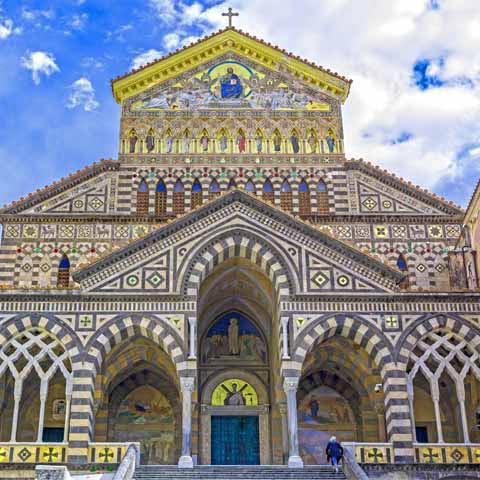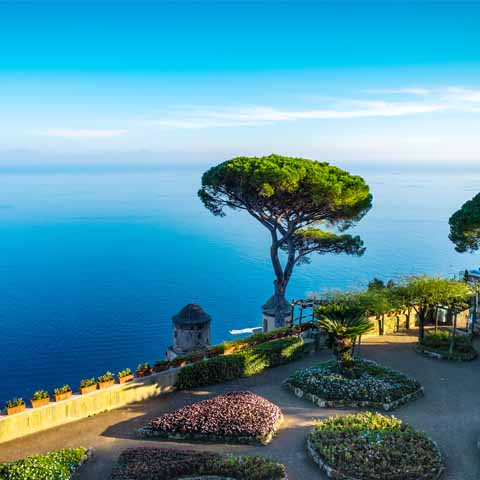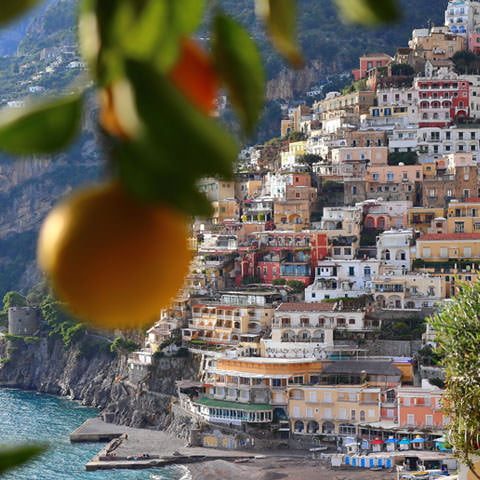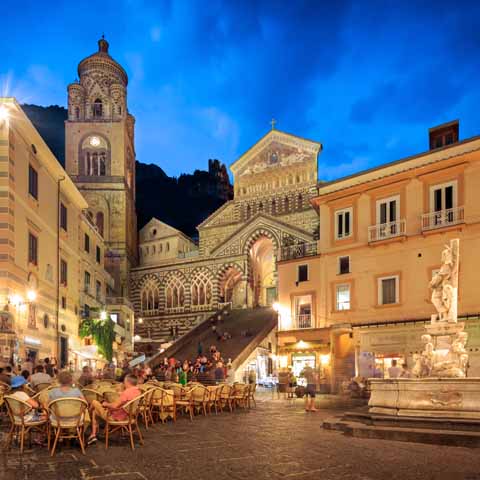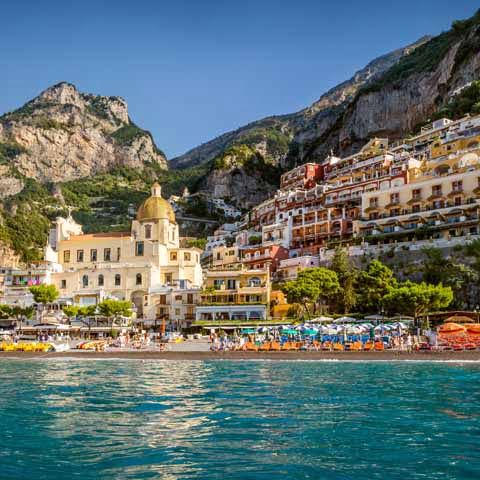The Amalfi Coast is a true treasure found on Italy’s southwestern coast on the Sorrentine Peninsula. It is widely regarded as one of the most beautiful stretches of coastline in the country, with stunning seaside views, charming villages and cities, and lovely beaches tucked in between. This part of Italy is best known for its natural beauty and is also home to a vibrant culture featuring amazing architecture, art, craftsmanship, music, and cinematic history.
AMALFI COAST CULTURE – Architecture
The scenic landscape of the Amalfi Coast can be summed up in one word: vertical. Due to the proximity between the dramatic cliffs and the waters of the sea, space is scarce, and the Amalfi Coast can be characterized by a strong relationship between nature and architecture. The urban architecture composed of churches, monuments, and houses was forced to adapt to the natural surroundings. When the villages of the Amalfi Coast were constructed, a balance was found between the undoubtedly marvelous, yet often hostile and inhospitable nature. From an architectural perspective, this led to creative and intriguing solutions, such as towns that were built in part along the coast and in part at a higher altitude on the cliffs.
The churches and cathedrals in this area are particularly striking. If visiting the town of Ravello, travelers will want to make a stop at the eleventh century Duomo di Ravello, which is located in the heart of the town. This charming church features a simple, primarily light colored exterior with a large bronze door at the main entryway and a concrete stairway leading up to it. The church’s bell tower is composed of Moorish and Byzantine elements. The interior of the church is light in color as well and dazzles with stunning simplicity primarily found in the pulpit, which is supported by artistic spiraled columns and marble lion statues. Of particular note are the stunning mosaics found throughout the church depicting religious scenes such as Jonah and the whale.
One of the most beautiful examples of architecture on the Amalfi Coast is the Amalfi Cathedral of Sant’Andrea, which features Arab, Norman, Gothic, Renaissance, and Baroque influences. This gorgeous church is quite striking with a steep and long staircase that leads up to the main building, providing ample space to admire the cathedral’s remarkable multi-colored façade. The exterior of the church is marked by three grand entryways, arched windows, square panels of artistic symbols, two triangular roof points, and more details than the eye can take in. The interior of the church is even more grand and ornate than the exterior, with a long center aisle that is tiled in light and dark colors and elaborate stunning gold accents on the ceiling. Be sure to leave yourself plenty of time to linger here and take in the beauty.
Adjacent to the Cathedral of Amalfi is the Chiostro del Paradiso (Cloister of Paradise). This Moorish structure was created in the thirteenth century and features an intricately landscaped courtyard surrounded by mesmerizing rows of ornate columns and arches. As the perfect place to unwind, the cloister lives up to its name and is not to be missed when planning a visit to the nearby Amalfi Cathedral.
The town of Praiano is home to the Church of San Gennaro. This small church is beautiful in its own right but is even more so on a sunny day next to the bold blue water of the Tyrrhenian Sea. The exterior of the church is beige in color and features a bell tower and dome decorated with colorful maiolica tile. Inside, travelers will find maiolica tile artwork and elaborate arches throughout. This church is one of very few examples of Baroque architecture in the Amalfi Coast.
If the colorful maiolica tiles of the Church of San Gennaro caught your attention, be sure to spend some time in Positano admiring the captivating dome of the Church of Santa Maria Assunta. A stunning example of medieval architecture, the church has strong connections to the local Benedictine Abbey of Santa Maria and is renowned for its Byzantine icon of the Madonna.
The Convent of San Nicola in Minori is another favorite architectural stop for tourists. This small and unassuming church offers one of the most stunning views of the Tyrrhenian Sea on the Amalfi Coast as it sits perched at the top of a hill nearly 1,600 feet above sea level. Built in the early seventeenth century by Augustan friars, the structure has been recently renovated. The path up to the convent can be difficult for some but offers beautiful scenery along the way.
A quite distinctive example of local architecture can be admired in a hamlet of the town of Tramonti called Gete. Known as the Cappella Rupestre (Rocky Chapel), this thirteenth century chapel is located inside of a cave. Constructed with both Gothic and Roman elements, the interior houses the remains of a pagan necropolis.
Another integral part of the Amalfi Coast’s architecture are the coastal towers that once defended the villages of the area during the Middle Ages and Renaissance. Today approximately thirty towers remain standing, with a few notable examples including the Grado Tower in Praiano, the Fornillo Tower in Positano, and the Cetara Tower in Cetara. These breathtaking towers that continue to watch over the coast serve as a testament to the eight hundred years of Saracen pirate raids of the villages of the Amalfi Coast.
It is interesting to note that the defensive towers can actually be divided into two categories. The oldest towers were constructed during the Angevin period and are characterized by their cylindrical shape and few windows. The main function of these tall and thin towers was to serve as a warning system. When the town was determined to be in danger, a fire would be lit on the tower to warn the citizens who would then seek shelter. Not many of these towers are still standing, though one notable exception is the Ziro Tower, which was built in 1480 and whose ruins overlook the town of Amalfi.
The second type of defensive tower dates back to the sixteenth century, when the pirate raids drastically escalated. As a result, Don Pedro of Toledo, the viceroy of Naples at the time, oversaw the construction of a new defense system with numerous towers spaced out along the coast. These towers were heavily fortified with thick external walls. They were also larger than the previous towers and were built in a square-shape with more lookout areas. Featuring artillery, the towers had multiple functions, which included sighting, signaling, providing shelter, and actively firing upon hostile ships spotted in the vicinity of the coast. Today some of the remaining towers are open to the public, while others have been transformed into luxury villas.
ART
In addition to traditional works of art such as paintings and sculptures, art in the Amalfi Coast can also be found in the form of artisan craftsmanship, such as ceramics, terra cotta, and handmade leather sandals. In some cases, a factory or workshop where these historic items are made may be available for a guided tour to learn about production techniques that have been used for centuries. With an area as rich in natural wonders as the Amalfi Coast, it is no surprise that it is a favorite of travelers and artists.
In terms of traditional art, Gaetano Capone was a nineteenth and twentieth century Italian painter known for painting rich landscapes. He was born in Maiori into a family of painters. He traveled throughout Italy furthering his art studies and education for some time before returning to Maiori to assist with painting frescoes in several local churches, including the Maiori Cathedral. Capone’s painting style, which integrated landscapes and aspects of the Amalfi Coast’s culture, resulted in a local school of painting known as Costaioli.
Luigi Paolillo is another Italian painter born in Maiori who was a student of Gaetano Capone and a Costaioli painter. He is known locally for his detailed paintings of the seashores in Campania, particularly those of the Amalfi Coast.
Other notable artists from the Amalfi Coast include Maiori natives Antonio Ferrigno and Angelo Della Mura as well as Pietro Scoppetta, who was from Amalfi. All of these painters were contemporaries of Luigi Paolillo.
International artists have been inspired by the Amalfi Coast as well, with the most notable example being the Dutch graphic artist M.C. Escher. Atrani is the subject of early work “Atrani, Coast of Amalfi”. As Escher developed his unique style of mathematical and repeating objects, landscapes of the Amalfi Coast and other parts of Italy were eventually featured in later works.
In addition to the native painters of the Amalfi Coast, many of the local churches and monuments house stunning artwork. One example is the Amalfi Cathedral which features works by Italian Baroque painter Andrea dell’Asta. Of particular interest is the Church of San Giovanni Battista in Praiano, which is renowned for its stunning maiolica tiled floor decorated with images of flora and fauna. A maiolica floor is also present in the Rococo style Cathedral of San Lorenzo in Scala.
As for local craftsmanship, Vietri sul Mare is renowned for its colorful hand painted ceramics featuring characteristic motifs, a tradition that dates back to the fifteenth century. The charming town is home to numerous workshops where the art of local artisans is on display and can be purchased. A hamlet of Vietri sul Mare, called Raito, hosts the Ceramics Museum with exhibits featuring religious ceramics as well as crockery.
SCIENZE
As a Maritime Republic, the town of Amalfi was the home of intrepid navigators for centuries. One notable local is Flavio Gioia, a thirteenth and fourteenth century mariner credited with improving the design of the compass, specifically its magnetism. Though not much is known about Flavio Gioia, his contributions to the compass proved invaluable to future generations of sailors.
LITERATURE
Just as with art, the Amalfi Coast has also been inspirational for authors over the centuries. During the Renaissance, the town of Ravello was described in Giovanni Boccaccio’s masterwork Decameron. A few centuries later, Ravello served as inspiration to French writer and later Nobel Prize winner Andrè Gide who set his 1902 novel The Immoralist in Ravello. English author D.H. Lawrence also drew inspiration from Ravello while writing the novel Lady Chatterley’s Lover.
Twentieth century American writer John Steinbeck was particularly taken with the area. He loved it so much that Positano was the focus of an essay he wrote in 1953 entitled Positano bites deep. At that time, Positano was just beginning to attract international travelers and Steinbeck’s essay helped popularize the destination. Other writers who visited the Amalfi Coast include Virginia Woolf, Gore Vidal, Truman Capote, Tennessee Williams, and Graham Greene.
Today the Amalfi Coast is commonly a setting for travel guides, cookbooks, and even novels. An extended trip to Italy’s Amalfi Coast might just be the inspiration an aspiring writer needs to make their work really sing.
MUSIC
Music is an integral part of the culture of the Amalfi Coast and is widely celebrated amongst locals. Two of perhaps the largest of musical events in the area include the Amalfi Music and Arts Festival and the Ravello Music Festival.
The Amalfi Music and Arts Festival is organized by the Center of Musical Studies of Washington together with the Accademia Jacopo Napoli of Salerno and Artis International. Taking place each July in Maiori, the festival features concerts held in some of the most beautiful locations in the Amalfi Coast and the vicinity, such as the Greek temples at Paestum. Classical and chamber music is represented during the festival with piano recitals as well as opera performances.
The Ravello Music Festival is one of the most delightfully picturesque ways to celebrate music. Several of the concerts held during the months-long festival are hosted at the Villa Rufolo, which offers stunning views of the Tyrrhenian Sea. The event celebrates classical music as well as other cultural works such as cinema and literature. It is dedicated to German composer Richard Wagner who was so amazed by the beauty of Villa Rufolo that its panoramic views inspired the set design of the opera Parsifal.
As for modern music, it is believed that members of the Rolling Stones, Mick Jagger and Keith Richards, wrote Midnight Rambler during a vacation to Positano.
CINEMA
The Amalfi Coast is a treasure for filmmakers worldwide and has a long history of appearing in movies that hit the big screen. Some of Italy’s most famous directors chose to make films in the Amalfi Coast, such as Roberto Rossellini who filmed the opening episode of 1946’s Paisà in Maiori. The director also filmed scenes of L’amore in Maiori, Atrani, and Furore, scenes of Viaggio in Italia in Maiori, and the entirety of La macchina ammazzacattivi in Atrani, Amalfi, and Maiori.
As for international productions, the Amalfi Coast has appeared at least in part in the following films: The African Queen (1951), Beat the Devil (1953), Only You (1994), Under the Tuscan Sun (2003), A Good Woman (2004), Mr. and Mrs. Smith (2005), Wonder Woman (2017), and Tenet (2020).
In addition to being featured in films, the Amalfi Coast is a favorite destination for actors, directors, and other members of the film industry to unwind. Legendary Italian director Franco Zeffirelli owned Positano’s Villa Treville for over three decades. This same villa is now a five-star hotel. Among the actors and actresses that have spent time in the Amalfi Coast are Grace Kelly, Greta Garbo, Sophia Loren, Tom Hanks, and Leonardo DiCaprio.
Begin planning your next trip to the Amalfi Coast today and count the ways for you to get lost in the local culture and natural beauty of this amazing land.
Travel Guides
The Campania Region of Italy
The Amalfi Coast
The Cities of Campania:
